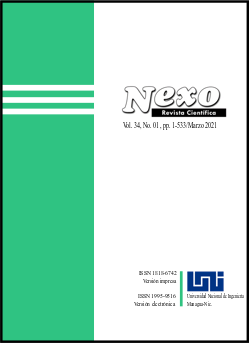Síntesis de una estructura nanoporosa de metal orgánico para el suministro controlado de azatioprina
DOI:
https://doi.org/10.5377/nexo.v34i01.11290Palabras clave:
MOF, estructura nanoporosa, MNP, liberación de fármaco, azatioprinaResumen
Los nuevos sistemas de administración de fármacos son altamente eficientes en el diagnóstico y tratamiento de enfermedades y también en la liberación controlada de fármacos. El uso de esta tecnología ha dado lugar a la invención de nuevas nanopartículas porosas que se denominan estructuras organometálicas (MOF). En la presente investigación, una especie de MOF con fórmula Cu3 (BTC) 2 (HKUST-1, BTC ¼ benceno-1,3,5-tricarboxilato) con nanopartículas magnéticas (MNP) de Fe3O4 como núcleo han podido crear tres- estructuras porosas magnéticas dimensionales. Esta estructura magnética y porosa y la capacidad de control de los poros han hecho que estas estructuras se utilicen como uno de los mejores vehículos en la administración de fármacos. Este sistema podría dirigirse magnéticamente al punto considerado dentro del cuerpo si contiene un medicamento que tiene efectos secundarios y puede dañar otros órganos del cuerpo. La azatioprina se usa en artritis reumatoide, granulomatosis con poliangeítis, enfermedad de Crohn, colitis ulcerosa, lupus eritematoso sistémico y en trasplantes de riñón para prevenir el rechazo. Sin embargo, en el presente trabajo consideramos la inyección de fármacos para trasplantes de riñón para prevenir el rechazo.
Descargas
1350
Descargas
Publicado
Cómo citar
Número
Sección
Licencia
Los autores que publican en Nexo Revista Científica están de acuerdo con los siguientes términos:
- Los autores conservan los derechos de autor y conceden a la revista el derecho de la primera publicación bajo la licencia Creative Commons Attribution License, que permite a otros compartir el trabajo con un reconocimiento a la autoría de la obra y a la publicación inicial en Nexo Revista Científica.
- Los autores pueden establecer por separado acuerdos adicionales para la distribución no exclusiva de la versión de la obra publicada en la revista (por ejemplo, en un repositorio institucional o en un libro) con el reconocimiento de su publicación inicial en Nexo Revista Científica.
- Se permite y se anima a los autores a difundir sus trabajos electrónicamente (por ejemplo, en repositorios institucionales o en su propio sitio web) antes y durante el proceso de envío, ya que puede dar lugar a intercambios productivos, así como a una citación más temprana y mayor de los trabajos publicados.










